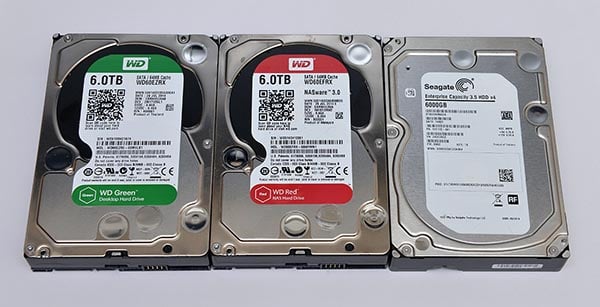6 TB Hard Drive Round-Up: WD Red, WD Green, Seagate Enterprise
Introduction and Specifications
The hard drive market has become a lot less sexy in the past few years thanks to SSDs. What we used to consider "fast" for a hard drive is relatively slow compared to even the cheapest of today's solid state drives. But there are two areas where hard drives still rule the roost, and that's in terms of overall capacity and cost per gigabyte. Right now you can buy a 4TB hard drive for the same cost as a 256GB SSD, so the two are in separate universes in that regard. We love SSDs and think just about everyone should run their OS on one, but most aren't large enough to hold all user data over a long period of time, so we still need hard drives for bulk storage duties, and will continue to need them until we can buy similar capacity SSDs at similar prices.
Since most of us still need a hard drive, the question naturally becomes, "How big of a drive do you need?" The market had been stuck at 4TB for a while, leaving content creators and media aficionados in a lurch as storage demands grew. That's all about to change though, as recently Seagate, HGST, and Western Digital announced a breakthrough in areal density and other technologies, and 6TB drives were finally delivered to market. Though Hitachi chose to take a unique approach with Helium, both Seagate and WD have taken a more traditional route by packing more bits per platter and more platters into their drive enclosures. As a result, the three drives we are looking at in this roundup are similar in their construction — with no fancy gasses or anything like that.

Find WD Red, WD Green and Seagate Enterprise Capacity 6TB HDDs at Amazon
Before we examine each drive individually, we'll point out that there are some stark differences between the Seagate and WD drives right off the bat. First and foremost, the Seagate drive utilizes a 7,200rpm spindle speed while the WD drives are both labeled "Intellipower" on their spec sheets, which is a creative way of saying they're lower-RPM drives with spindle speeds as low as 5400 RPM.
Another difference that should have a profound impact on performance between the drives is that Seagate reached 6TB by adding one more platter to its design, so it uses a total of six instead of five. WD however is still using a standard five platter design that we've seen in all the previous high capacity drives, but has instead boosted capacity by increasing areal density. This will further help the WD drive conserve energy since its drives have fewer platters to spin, and should help performance too thanks to higher areal density affording less travel time for its access head on a read or write.
|
|
|

All three drives are offered in a variety of speeds and capacities, but this review doesn't cover the entire family of these drives, so pay attention to the model number if and when you decide to order one, as platter configurations and performance varies according to capacity. To start things off, let's look at each of our contenders...






